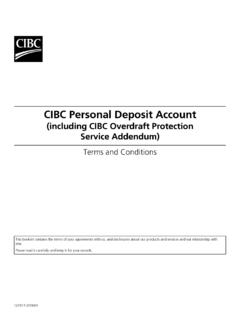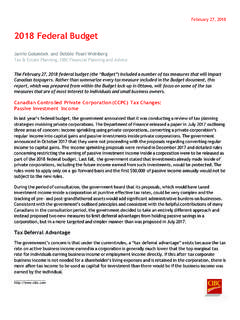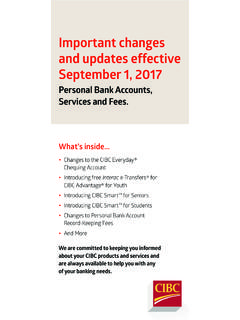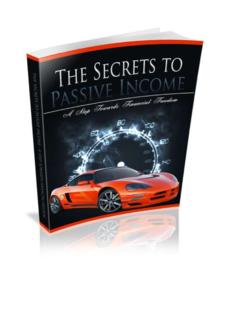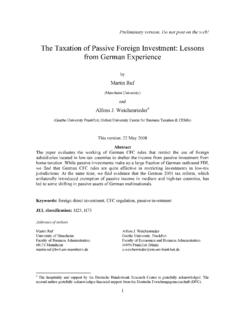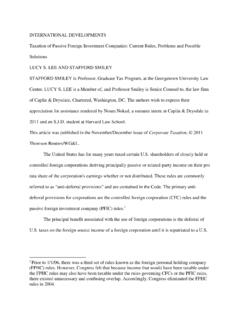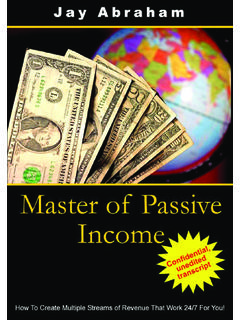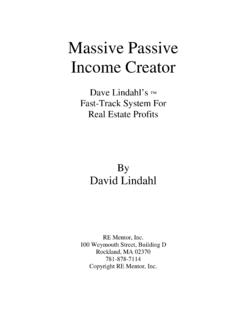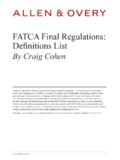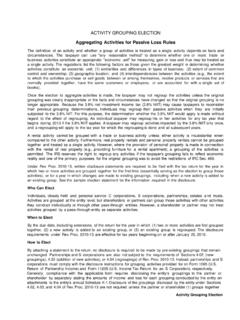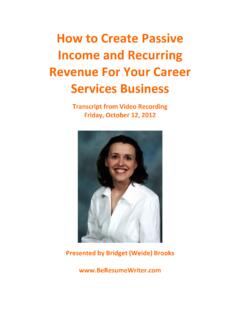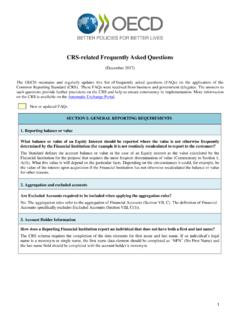Transcription of CCPC tax planning for passive income - cibc.com
1 November 15, 2018 CCPC Tax planning for passive income Jamie Golombek & Debbie Pearl-Weinberg Tax & Estate planning , CIBC Financial planning and Advice In 2018, the government enacted new tax legislation governing Canadian-controlled private corporations (CCPCs), including incorporated professionals. As we enter the final months of 2018, one new measure is of particular concern the potential looming loss of the small business deduction (SBD) in 2019 for corporations with more than $50,000 of passive investment income in 2018. This Report will review the new rules, the potential financial impact of a loss in the SBD on your long term savings, and what you can do about it. Background income from your CCPC can be distributed to you as salary (or bonus) if you are an employee, or dividends as a shareholder. If you receive salary, your corporation will receive a tax deduction for the salary paid so no corporate tax would be payable on the income .
2 You would simply pay personal tax at the graduated personal tax rates on any salary you receive from your If you don t take out all your corporation s net income as salary, the net income remaining will be subject to corporate tax and the after-tax income can then be distributed to you as a dividend, either immediately or in the future. You would pay personal income tax on dividends you receive in the year, at your graduated marginal tax rates. The theory of tax integration looks at how closely the personal income tax you would pay on salary compares to the combined corporate/personal income tax that would be paid on dividends. If there is perfect tax integration, you should be indifferent between earning salary or dividends because the same amount of total tax will be paid either way. There is no Tax Savings (or Tax Cost), which refers to the tax that is saved (or additional tax that is paid) if business income is earned in your corporation and distributed to you as a dividend, rather than salary.
3 There may, however, still be a significant Tax Deferral (or Tax Prepayment), which refers to the tax that is deferred (or paid in advance) if business income is distributed to you as a dividend in a later year, rather than salary in the current year. This Tax Deferral (or Tax Prepayment) could be advantageous (or disadvantageous) if you defer payment of a dividend and the related personal tax to a future year. More information is available in our report, Bye Bye In 2018, assuming you pay tax at the top marginal tax rate,3 there is near-perfect integration for business income in most provinces, so there is little Tax Savings (or Tax Cost) if distributions are made as dividends, rather than salary. But as top personal tax rates have increased and corporate tax rates have decreased in recent years, the Tax Deferral (which is the difference between the personal and corporate tax rates) has become quite significant.
4 1 Payroll taxes, such as premiums for the Canada/Quebec Pension Plan, Employment Insurance or provincial health taxes, that may be payable when income is distributed as salaries have not been considered. 2 The report Bye Bye Bonus is available online at 3 Throughout this report, it is assumed that you are the shareholder of a CCPC (your corporation) and you pay tax at the highest marginal tax rate on income distributed from your corporation. CIBC CCPC Tax planning for passive income November 15, 2018 2 Tax Deferral In 2018, the top personal marginal tax rate that you would pay on ordinary income , including salary or bonus, ranges from in Saskatchewan to 54% in Nova Scotia. The SBD is available if your CCPC earns active business income up to the annual small business limit (SBD Limit), which in 2018 is $500,000 federally and in most income that is eligible for the small business deduction (SBD income ) is taxed inside your corporation at a lower, small business deduction tax rate (SBD Rate) that ranges from 10% in Manitoba to 17% in Quebec in 2018 when federal and provincial taxes are combined.
5 Associated corporations must share the SBD. In 2018, if your corporation earns active business income (ABI) that is not eligible for the SBD, there is a higher, general corporate tax rate that ranges from in Ontario to 31% in Nova Scotia and Prince Edward Island when federal and provincial taxes are combined. As a result, in 2018 there is significant Tax Deferral of federal and provincial taxes, ranging from to 41% for SBD income as shown in Figure 1 and ranging from to 27% for ABI as shown in Figure 2. Figure 1: Combined federal/provincial Tax Deferral on SBD income left in the corporation for all provinces in 2018 4 For large CCPCs, the federal and provincial SBD Limit is reduced on a straight-line basis for CCPCs that, in the prior tax year, had taxable capital between $10 million and $15 million. In Saskatchewan, the SBD Limit is $600,000.
6 In Manitoba, the SBD Limit is $450,000 in 2018 but will rise to $500,000 in 2019. Figure 2: Combined federal/provincial Tax Deferral on ABI left in the corporation for all provinces in 2018 CIBC CCPC Tax planning for passive income November 15, 2018 3 The New Rules for passive income When business income is distributed as salary (or when an unincorporated business owner earns business income personally), the business owner must pay full personal tax in the year the income is earned. When business income is distributed as dividends, the corporate tax on the business income is lower than the personal tax rate on salary, and personal tax on the dividend is only payable when the dividend is paid. If dividend payments are deferred to a future year, additional funds are available to invest in the corporation in the interim, which may yield more investment income over time compared to a business owner who invests after-tax salary personally.
7 The government thought that this provided an unfair benefit for owners of CCPCs who chose to defer personal taxes by delaying the payment of dividends and build up significant funds in their corporations. With particularly low SBD Rates, the potential benefit from the large Tax Deferral with SBD income (Figure 1) was of most concern. The new tax rules will, therefore, limit the potential future benefits from the Tax Deferral on SBD income by reducing the SBD Limit when a corporation has significant passive income in the previous year. Beginning in 2019, the federal $500,000 SBD Limit will be reduced for CCPCs based on levels of adjusted aggregate investment income (AAII) in the previous year. The SBD Limit will be reduced by $5 for each $1 of AAII that exceeds $50,000 and will reach zero once $150,000 of AAII is earned in a year. Additional information regarding AAII and the reduction to the SBD Limit is available in our report, The updated CCPC tax In practical terms, this means that if your corporation has at least $50,000 of AAII in 2018, then in 2019 some (or all) of the income that would have qualified as SBD income will be taxed as ABI.
8 On November 15, 2018 the Ontario government announced that it will not follow this federal measure, so active business income up to $500,000 will continue to qualify for the Ontario small business To date, Ontario is the only province that has announced that it would not follow the federal rules limiting the SBD based on passive income . In this report, it is assumed that provinces other than Ontario will follow the federal rules. Just as associated corporations share the SBD Limit, AAII is combined for associated corporations and the $50,000 threshold is shared between them. You may be surprised to find that another corporation with only a somewhat remote connection may be associated with your corporation. For instance, for the purpose of the new rules you are deemed to personally own shares held by a trust in which you or your minor child is a beneficiary, so your corporation could be associated with another corporation where the only connection is shares held by a family Impact of Losing the SBD Is losing the SBD a big deal?
9 The short answer is it depends! If you are going to take the after-tax business income out of the company in the year it s earned, then you re not enjoying any Tax Deferral and the loss of the SBD is likely immaterial. Since there s near-perfect 5 The report The updated CCPC tax proposals is available online at 6 Announced in the 2018 Ontario Economic Outlook and Fiscal Review, which is available online at 7 For further information see "The passive Investment Rules and Their Associates", Michael Goldberg, Tax Topics (Wolters Kluwer), No. 2426, September 6, 2018, which is available online at CIBC CCPC Tax planning for passive income November 15, 2018 4 integration for both SBD income and ABI, the total corporate and personal taxes will be about the same with either dividends or salary.
10 Figure 3 quantifies the after-tax amount that you ll receive if $500,000 of business income is paid as salary (first column) or as dividends (columns 2 and 3), using Alberta 2019 tax rates. Figure 3: After-tax amount to business owner when $500,000 of active business income is distributed as salary or dividends in Alberta in 20198 - Salary Dividends SBD income Dividends ABI Dividends Difference CORPORATION: - - - - Active business income 500,000 500,000 500,000 0 Salary expense (500,000) 0 0 0 Taxable income 0 500,000 500,000 0 Corporate tax 0 (55,000) (135,000) (80,000) Amount available for dividends / investment 0 445,000 365,000 (80,000) BUSINESS OWNER: - - - - Salary / dividend 500,000 445,000 365,000 (80,000) Personal tax (240,000) (189,392) (115,742) 73,650 After-tax amount to business owner 260,000 255,608 249,258 (6,350) Total corporate/personal tax amount 240,000 244,392 250,742 6,350 Total effective tax rate In Figure 3, if you earned business income personally, you would pay tax of 48%.
